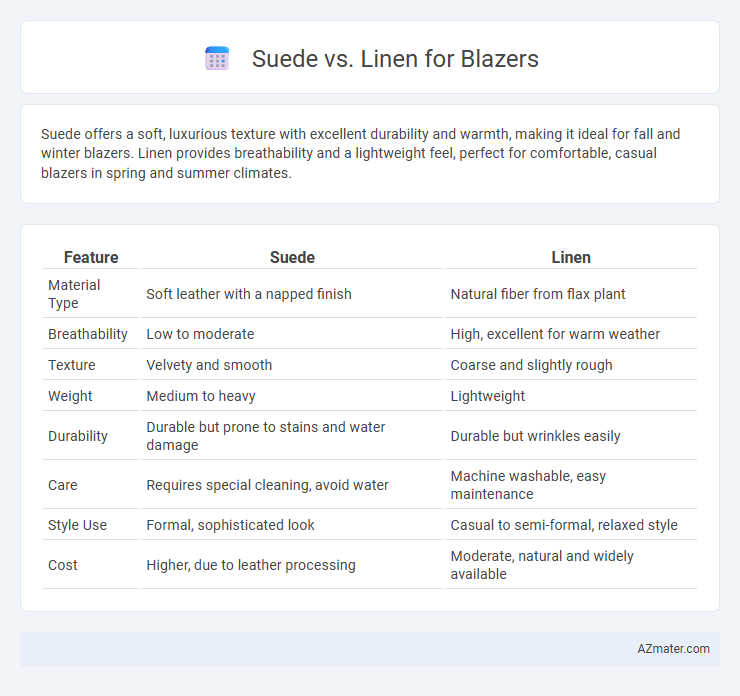Suede offers a soft, luxurious texture with excellent durability and warmth, making it ideal for fall and winter blazers. Linen provides breathability and a lightweight feel, perfect for comfortable, casual blazers in spring and summer climates.
Table of Comparison
| Feature | Suede | Linen |
|---|---|---|
| Material Type | Soft leather with a napped finish | Natural fiber from flax plant |
| Breathability | Low to moderate | High, excellent for warm weather |
| Texture | Velvety and smooth | Coarse and slightly rough |
| Weight | Medium to heavy | Lightweight |
| Durability | Durable but prone to stains and water damage | Durable but wrinkles easily |
| Care | Requires special cleaning, avoid water | Machine washable, easy maintenance |
| Style Use | Formal, sophisticated look | Casual to semi-formal, relaxed style |
| Cost | Higher, due to leather processing | Moderate, natural and widely available |
Introduction to Suede and Linen Blazers
Suede blazers are crafted from the underside of animal hides, offering a soft texture with a luxurious, velvety finish that enhances formal and casual styles alike. Linen blazers, made from natural flax fibers, provide breathability and lightweight comfort, ideal for warm weather and a relaxed yet polished appearance. Both materials bring distinct textures and functionality, catering to different seasons and fashion preferences.
Fabric Origins: Suede vs Linen
Suede originates from the underside of animal hides, primarily lamb, goat, or calf leather, offering a soft, napped finish ideal for structured, stylish blazers. Linen, derived from the flax plant, is a natural cellulose fiber known for its breathable, lightweight qualities, making it perfect for warm-weather, casual blazers. The contrasting origins influence durability, texture, and climate suitability, with suede providing a luxurious, textured appearance, while linen emphasizes comfort and ventilation.
Texture and Appearance Comparison
Suede blazers feature a soft, velvety texture that exudes luxury and warmth, making them ideal for fall and winter wardrobes. Linen blazers boast a lightweight, breathable fabric with a natural, slightly rough texture that enhances casual elegance and breathability, perfect for spring and summer wear. The matte finish of suede provides a rich, plush appearance, while linen's weave creates a more relaxed, rustic look with visible natural fibers.
Seasonal Suitability: Which is Best for Each Season?
Suede blazers offer excellent warmth and durability, making them ideal for fall and winter when insulation and wind resistance are essential. Linen blazers provide breathability and moisture-wicking properties, perfect for spring and summer as they keep the wearer cool in hot, humid conditions. Choosing between suede and linen depends on seasonal requirements: suede for cold weather and linen for warm, allowing comfort and style throughout the year.
Comfort and Breathability
Linen blazers excel in comfort and breathability due to their lightweight, natural fibers that allow for excellent air circulation, making them ideal for warm weather. Suede blazers, while offering a soft and luxurious feel, tend to be less breathable and can retain heat, which may cause discomfort in higher temperatures. For optimal comfort in hot climates, linen is the superior fabric choice, whereas suede is better suited for cooler environments.
Durability and Maintenance
Suede blazers offer a luxurious texture but require careful maintenance to prevent water stains and damage, making them less durable in wet or high-humidity environments. Linen blazers are highly breathable and easy to maintain, but the fabric is prone to wrinkles and can wear out faster with frequent use, especially at stress points like elbows. For long-lasting wear, suede demands special cleaning products and storage, while linen benefits from gentle washing and regular ironing to maintain its appearance.
Style Versatility and Occasions
Suede blazers offer a rich texture and a sophisticated appearance, ideal for smart-casual and evening events, adding depth to fall and winter wardrobes. Linen blazers provide lightweight breathability and a crisp, casual look, perfect for warm weather, daytime gatherings, and beach weddings. The style versatility of suede suits cooler seasons and formal settings, while linen excels in relaxed environments and summer occasions.
Color Options and Patterns
Suede blazers typically offer richer, deeper color options like warm browns, navy, and forest green, providing a luxurious and textured appearance ideal for fall and winter wear. Linen blazers come in lighter, more vibrant colors such as beige, light gray, pastel blue, and white, emphasizing breathability and coolness suited for spring and summer seasons. Pattern choices for suede are generally solid or subtly distressed, while linen blazers often feature a wider range of patterns, including checks, stripes, and heathered weaves for versatile styling.
Price Range and Value
Suede blazers typically fall within a higher price range due to the premium quality and distinctive texture of the leather, often costing between $300 and $800 or more. Linen blazers are generally more affordable, with prices ranging from $100 to $400, offering excellent breathability and lightweight comfort ideal for warm climates. The value of suede lies in its durability and luxurious appearance, while linen provides great versatility and comfort, making each material suitable for different style and budget preferences.
Suede vs Linen: Which Blazer Should You Choose?
Suede blazers offer a luxurious texture and warmth ideal for cooler seasons and formal occasions, while linen blazers provide lightweight breathability and a casual, relaxed look perfect for summer and outdoor events. Suede's durability and smooth finish make it a sophisticated choice, whereas linen's natural fibers allow superior ventilation and comfort in hot climates. Choosing between suede and linen depends on the desired style, climate, and occasion, with suede excelling in elegance and linen shining in comfort.

Infographic: Suede vs Linen for Blazer
 azmater.com
azmater.com